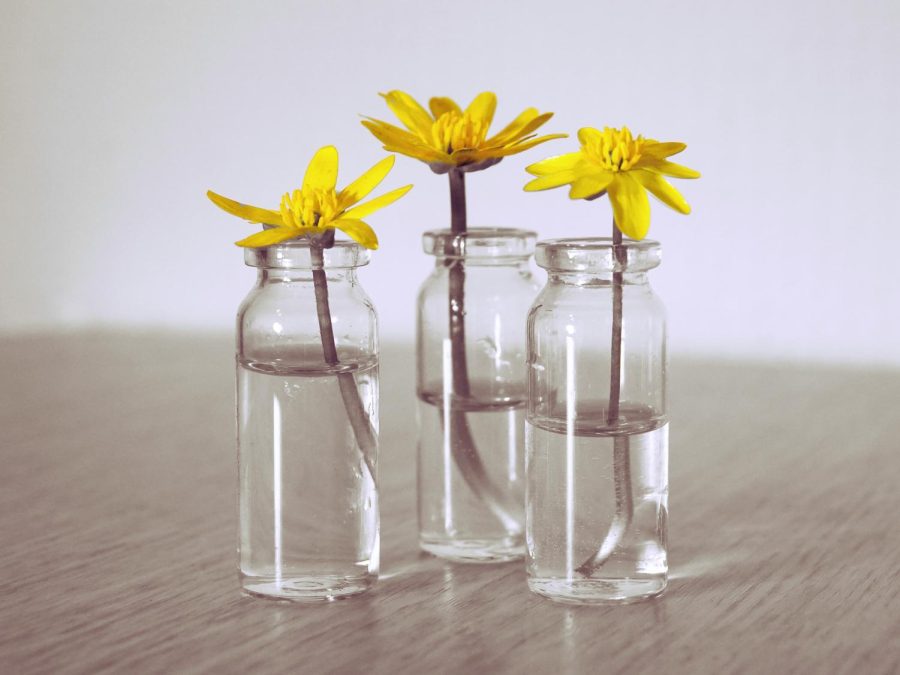Praise for the Humble Glass Vessel
October 7, 2022
Pristine. Elegant. Practical. The glass container is one of versatility and resource. First invented in 1500 B.C.E., these water-proof and heat-proof vessels have served humanity ever since. Glass containers exist in a variety of shades, from corally pinks to soothing aquamarines, and in shapes from spheric to root-like. In its most common presentation, the glass vessel takes on a sleek cylindrical form with a variety of adornments–taper the top and it becomes a bottle, pinch the mouth and it becomes a beaker, add a handle to the aforementioned two and it becomes a pitcher.
As the access to glass material has increased, we’ve been disillusioned into a “use, don’t reuse” cycle, producing nearly 41 billion glass containers annually and discarding just as much. Because glass is labeled as “recyclable”, we tend to treat it like it’s degradable; we buy in huge quantities and toss it away without so much as a thought. Glass is an energy-intensive product (heating sand to 3000 °F doesn’t come without costs). By choosing to treat this object as disposable, we are rejecting the creative histories of the glass container. Recycling glass does offer us a sliver of remorse, but realistically, less than 31% of glass in the U.S. is actually recycled.
While this convenient setup has served us well in the last century, it’s time we start caring about what we buy and what we dump. Landfills are growing exponentially, and further mass production of disposable items doesn’t bode well for the future of our boiling planet. Glass, for example, is a seriously sturdy material; it doesn’t scratch easily, dent, or erode. Instead of burning through tons of glass a year, we should focus on the simple reuse and repurposing of glass vessels.
For example, jars, a pantry staple, often meet the end of their lives once they are emptied of their original contents. However, they are perfectly functioning storage containers that can be reused in a multitude of ways. That empty marinara jar can dual as a pencil holder. Those baby-food jars are perfect for portioning out yogurt servings. The pickle container can now keep beans or oats dry.
Arcadia High School junior Joss Lau is a habitual glass connoisseur, and her favorite way to put her vessels to use may seem interesting to some.
“I put water in [glass containers] and propagate my plants,” she said. “Basically [propagation] is when you cut the top of a plant and you put it in water. It grows roots in the water, and once it grows roots, you put it in soil and get a new plant.”
Additionally, simple adornments can transform basic glass containers into aesthetic decor. Take, for instance, the classic DIY “twine and jar”, where rustic brown twine is wrapped around some form of glass container, then used either as stand-alone decoration or used as a planter or other container. Paint and decorative tape can also take glass a long way, creating a memorable and modern space.
Lau’s collection of glass containers is immense, but she still pays special attention to her favorite item.
“My favorite glass jar is a jam jar—it used to have strawberry jam inside,” she said. “The shape is, like, so pretty! It’s skinny in the top and curves outward then tapers back at the bottom, sort of like a heart.”
With so many varieties and beautiful bodices, you may be wondering how you can continue to keep glass jars without becoming a hoarder over time. Well, certain grocery stores sell produce and other products in a large, self-serve scale known as bulk food. Customers bring their own bags or containers and happily stock up on the latest pasta or whole grain blend without having to worry about the multitudes of plastic or glass packaging from typical consumer products. Not only do these lessen our waste production, but also allow buyers to portion their purchases according to personal preferences, potentially reducing food waste from excess servings.
With these simple changes to our habits, reducing, reusing, and repurposing glass can lessen the amount of waste we produce and even enrich our lives with the beauty in these vessels’ simplicity. By putting more care into preserving the glass on hand, we can add a sparkle to a crystalline, clean world.
Photo courtesy of UNSPLASH.COM

